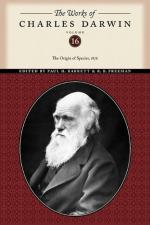of the breeds is something astonishing. Compare
the English carrier and the short-faced tumbler, and
see the wonderful difference in their beaks, entailing
corresponding differences in their skulls. The
carrier, more especially the male bird, is also remarkable
from the wonderful development of the carunculated
skin about the head, and this is accompanied by greatly
elongated eyelids, very large external orifices to
the nostrils, and a wide gape of mouth. The short-faced
tumbler has a beak in outline almost like that of a
finch; and the common tumbler has the singular and
strictly inherited habit of flying at a great height
in a compact flock, and tumbling in the air head over
heels. The runt is a bird of great size, with
long, massive beak and large feet; some of the sub-breeds
of runts have very long necks, others very long wings
and tails, others singularly short tails. The
barb is allied to the carrier, but, instead of a very
long beak, has a very short and very broad one.
The pouter has a much elongated body, wings, and legs;
and its enormously developed crop, which it glories
in inflating, may well excite astonishment and even
laughter. The turbit has a very short and conical
beak, with a line of reversed feathers down the breast;
and it has the habit of continually expanding slightly
the upper part of the oesophagus. The Jacobin
has the feathers so much reversed along the back of
the neck that they form a hood, and it has, proportionally
to its size, much elongated wing and tail feathers.
The trumpeter and laugher, as their names express,
utter a very different coo from the other breeds.
The fantail has thirty or even forty tail-feathers,
instead of twelve or fourteen, the normal number in
all members of the great pigeon family; and these
feathers are kept expanded, and are carried so erect
that in good birds the head and tail touch; the oil-gland
is quite aborted. Several other less distinct
breeds might have been specified.
In the skeletons of the several breeds, the development
of the bones of the face in length and breadth and
curvature differs enormously. The shape, as well
as the breadth and length of the ramus of the lower
jaw, varies in a highly remarkable manner. The
number of the caudal and sacral vertebrae vary; as
does the number of the ribs, together with their relative
breadth and the presence of processes. The size
and shape of the apertures in the sternum are highly
variable; so is the degree of divergence and relative
size of the two arms of the furcula. The proportional
width of the gape of mouth, the proportional length
of the eyelids, of the orifice of the nostrils, of
the tongue (not always in strict correlation with
the length of beak), the size of the crop and of the
upper part of the oesophagus; the development and
abortion of the oil-gland; the number of the primary
wing and caudal feathers; the relative length of wing
and tail to each other and to the body; the relative
length of leg and of the feet; the number of scutellae




